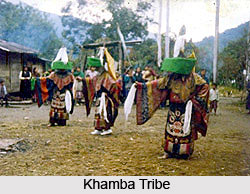 The Khamba tribes are scattered around the Yang-Sang-Chu valley of West Siang of Arunachal Pradesh. This valley is also known as Yongyap valley that lies near the Tibetan border. The tribes have their own villages namely Lango, Nyukong, Tashigong, Mangkota and Yorton. They are the minuscule tribal community of northern Siang district.
The Khamba tribes are scattered around the Yang-Sang-Chu valley of West Siang of Arunachal Pradesh. This valley is also known as Yongyap valley that lies near the Tibetan border. The tribes have their own villages namely Lango, Nyukong, Tashigong, Mangkota and Yorton. They are the minuscule tribal community of northern Siang district.
As per their past history, the Khamba tribes migrated to India from Tibet before the advent of Lord Buddha. The Khamba people are agrarian people and their major crop is paddy. Some other kinds of crops that are cultivated by these people include Job`s tears, millets, barley, maze, wheat, fruits and vegetables. Jhum cultivation is prevalent among them. They rear cows, mithan and pigs due to their inclination towards non vegetarian diet.
The women of this community are great weavers and they use back strap type loom that are called tension, Indonesian loom and loin. They are expert carpet weavers and the designs are majorly based on dragon motifs. It is said that as they have Tibetan origin, they might bring this tradition and style of weaving from Tibet. The Khamba males are expert in carpentry. They create various items with cane and bamboo. Items like caps, baskets, mats, rain caps etc are available in the local market. Apart from this, some also took up the profession of blacksmiths and they create different article for agricultural and their regular usage.
The villages of this tribal people are situated atop the hills and they position their agricultural fields on the hill slopes. The people of this tribal group are religious minded and there is a Buddhist monastery in each village. The monk is revered by the entire community.
The people of the Khamba tribal community of Arunachal Pradesh build their houses in raised platform. The walls of these houses are made with split bamboos and the roofs are thatched. The houses of the people of higher rank and status are bigger in size than the common people but they follow the same pattern in building houses. They keep a place for oven that is used for cooking purpose and room heater to keep themselves warm during the time of winter.
The Khamba tribes are animist and are superstitious. They also believe in evil spirits. Later this community was converted to Buddhism and chanting the sermons of Buddha and following Buddhist scriptures like Panchasheel, Tripitaka, Dashasheel and Ashtasheel are also part of their religious belief.
Festivals and occasional functions are the fart of the culture of Khamba tribes. Pantomimes are performed during their celebrations. This is enacted during Drubachuk and Trinda Chichuk festivals. Pantomimes are based on the achievements and success of the preceptors and during this enactment, drums, trumpets, conch, clarions and cymbals are played. A special kind of pantomime is enacted among this community named Guru Chenji. In this enactment, nine dancers perform the roles of nine preachers of Buddhism. This performance is enacted with an aim to suppress the evil spirits and for the well being of the human society and animals. In their new year, the celebrate Losar which is said to be the major festival of the Khambas.
The costumes of Khamba tribes have a clear influence of Tibet. The male costumes of this tribal group include full sleeved cloaks and shirts. The cloaks generally come to the length of knee in case of the men. The women costume comprises of a full sleeved blouse, an apron, a full sleeved black gown that reaches the knees and a skirt. They use belt in their waist. The females wear jewelleries made of brass, beads and ivory.
















